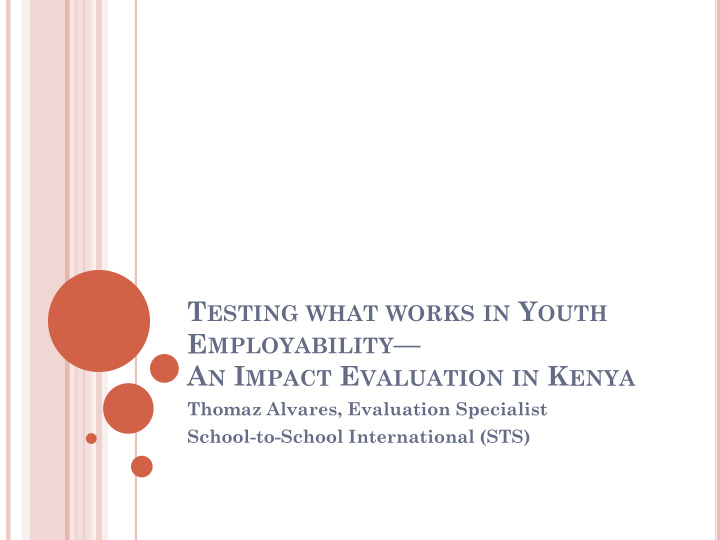



T ESTING WHAT WORKS IN Y OUTH E MPLOYABILITY — A N I MPACT E VALUATION IN K ENYA Thomaz Alvares, Evaluation Specialist School-to-School International (STS)
R OAD M AP Introduction Design Sampling Findings Evaluation Challenges and Responses
I NTRODUCTION The Ninaweza program is coordinated by the International Youth Foundation (IYF) with funding from the World Bank and Microsoft Ninaweza provides young women with: Technical training in Information Communication Technology (ICT) Life Skills training Work experience through internships Job placement support
I NTRODUCTION : R ESEARCH QUESTIONS 1. Does the Ninaweza training succeed in increasing participants’ knowledge of ICT and life skills? 2. Does the program (training + internships + job placement support) result in higher quality employment for the participants?
D ESIGN : I MPLEMENTATION 6 Cohorts of Participants (staggered implementation) Group 1: Treatment in Cohorts 1, 3, 5 Group 2: Treatment in Cohorts 2, 4, 6 Control: In all Cohorts (1 to 6)
D ESIGN : T ARGET Phases and Cohorts Phase 1 Phase 2 Phase 3 Group Cohort Cohort Cohort Cohort Cohort Cohort Total 1 2 3 4 5 6 Group 1 120 120 110 350 Group 2 120 120 110 350 Control 135 135 135 135 135 135 810 Total 510 510 490 1,510
D ESIGN : M ODEL
D ESIGN : R ANDOM A SSIGNMENT Treatment and control should be similar in all relevant characteristics Education? Family income? Motivation? … Random assignment allows assumption that groups are similar even on unobservable characteristics Difference-in-Difference + Random Assigment = RCT implies causality
S AMPLE Criteria: Residing in any of the six informal settlements 1. (slum areas) in and around Nairobi Female 2. Age 18-35 years 3. Completed high school 4. Out of school for at least one year 5. Not employed at the time of application 6.
Findings: Post-test (I) ICT test scores higher in T than C for all cohorts that received ICT training 40 ICT Control ICT Treatment * * * * * * 20 0 Pre Post Pre Post Pre Post Pre Post Pre Post Pre Post Cohort 1 Cohort 2 Cohort 3 Cohort 4 Cohort 5 Cohort 6 Life Skills test scores higher in T than C for all cohorts that received Life Skills training 40 * * * 20 0 Pre Post Pre Post Pre Post Pre Post Pre Post Pre Post Cohort 1 Cohort 2 Cohort 3 Cohort 4 Cohort 5 Cohort 6
Findings: Post-test (II) Treatment effect 25% 20% 20% 19% 17% 17% Cohort 1 14% Cohort 2 15% 13% Cohort 3 Cohort 4 10% 7% Cohort 5 6% 5% Cohort 6 5% 1% 1% 0% 0% ICT Life Skills
Findings: Exit Survey (I) Conf. that will find job Conf. in qualifications 100 100 80 80 60 60 C T1 40 40 T2 20 20 0 0 Pre Post Pre Post
Findings: Exit Survey (II) Currently employed Full-time employment 100 100 80 80 C 60 60 T1 40 40 20 T2 20 0 0 Pre Post Pre Post Weekly income 4000 3000 2000 1000 0 Pre Post
Findings: Cautionary Remarks Have looked for employment Cohort1 15.2% Cohort2 8.5% Cohort3 6.4% Cohort4 13.8% Cohort5 14.0% Currently employed Cohort1 11.2% Cohort2 22.9% Cohort3 11.3% Cohort4 11.8% Cohort5 Full-time employment Cohort1 48.6% Cohort2 19.5% Cohort3 25.2% Cohort4 3.7% Cohort5 4.2%
S UMMARY RCT established that Ninaweza training in ICT and Life Skills succeeded in increasing test scores 2 months later End-line interview suggests that treatment participants are more confident in their skill set, more optimistic in getting a job and more likely to obtain a full-time salaried position
Recommend
More recommend